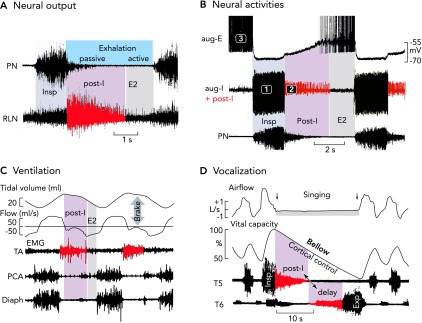FIGURE 1.

Neural and mechanical phases of a respiratory cycle in vivo
A: phrenic and recurrent laryngeal (RLN) nerve recordings in the anesthetized cat and rat reveal an augmenting inspiratory burst that ends abruptly. Thereafter, there appears a declining post-inspiratory discharge particularly strong in the RLN representing the neural control of laryngeal adductor muscles (83). B: simultaneous in vivo triplet recordings from three characteristic types of neuron in the anesthetized cat reveal a regular sequence of inspiratory (phase 1), post-inspiratory (phase 2), and late-expiratory (phase 3) discharges (action potentials are truncated) (77). C: the post-inspiratory discharge of laryngeal nerves activates a mechanical brake of the expiratory airflow and a holding of lung volume. Recordings are from the thyroarytenoid constrictor muscle (TA), the posterior cricoarythyoid dilator muscle (PCA), and the inspiratory diaphragm (Diaph) of halothane anesthetized lamb (see modified Figure 5 from Ref. 28). D: post-inspiratory activity controls vocalization. Recordings were from human inspiratory intercostal muscles in T5 and expiratory muscles in T6, and clearly show a significance of the post-inspiratory control of inspiratory and expiratory muscle activity during singing, which requires tight control of the breathing rhythm (85).
